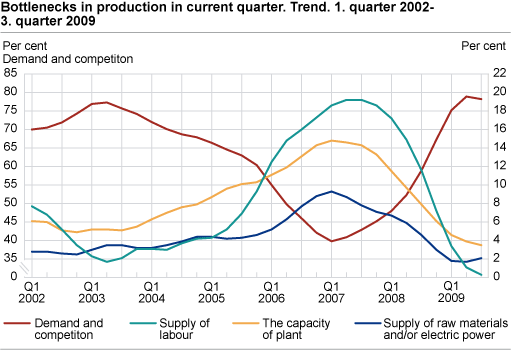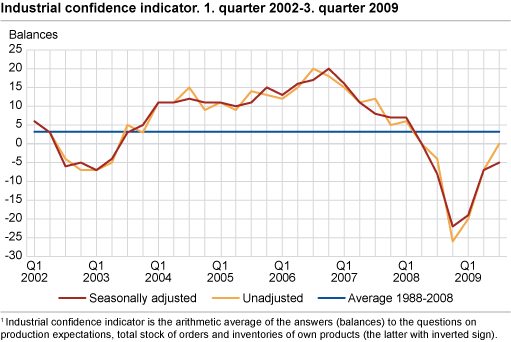Content
Published:
This is an archived release.
Still poor results for manufacturing
Norwegian industrial mangers report a slowdown in the decline in total output, but the overall picture is somewhat mixed. Poor demand for ships, boats and oil platforms constitutes a major challenge for parts of the manufacturing industry.
According to the business tendency survey, the Norwegian manufacturing industry experienced a fall in output and employment in the third quarter of 2009. However, the decline was less strong than recorded in the first 6 months of the year. Improved conditions for producers of intermediate goods contributed to this development. A lack of new orders in home and export markets caused total stocks to fall and had a negative effect on market prices. Poor demand and fierce competition played a major role in restricting production, while resource shortage (see table 16 ) was hardly a problem. The number of working months covered by the current stock of orders was almost the same as the historic average for the manufacturing industry. This is significantly lower than recorded in the corresponding quarter of 2008. Poor demand for ships, boats and oil platforms offers a partial explanation for this development. Average capacity utilisation is estimated to about 76.4 per cent, which is more or less the same as recorded in the previous survey. International comparisons of average capacity utilisation are available from EUROSTAT .
The general short-term outlook (Q4 2009) is still considered to be poor, but fewer respondents share this view. Expectations of improved conditions in export markets support this result. The industrial confidence indicator rose to -5 (seasonally-adjusted net figure) in the third quarter. A further reduction in stocks of finished goods (see table 17 ) contributed to this development. The result lies below the historic average and this indicates a further weakening of the business cycle. However, the decline in total output is expected to be somewhat smaller than in the previous quarter. International comparisons of the industrial confidence indicator are available from EUROSTAT (EU) and the Swedish National Institute of Economic Research (Sweden).
Mixed results for sectors producing intermediate goods
Sectors producing intermediate goods (wood and wood products, paper and paper products, non-metallic mineral products, basic metals etc.) experienced a further decline in output and employment. However, the results were somewhat mixed for different industries. Total stocks of orders were more or less unchanged from the previous survey, while market prices continued to fall. A strengthening of the Norwegian currency is a likely explanation for at least some of the decline in market prices. Average capacity utilisation is estimated to 75.1 per cent. The number of working months covered by the current stock of orders has been more or less unchanged since the fourth quarter of 2008.
The indicator covering the general short-term outlook in these sectors is changing from negative to neutral. Expectations of a higher demand in export markets and a slowdown in the decline in market prices support this result.
Poor demand for ships, boats and oil platforms
Sectors producing capital goods (machinery and equipment, ships, boats and oil platforms etc.) experienced tough conditions in the third quarter. There was a further decline in output and employment, and total stocks fell due to a lack of new orders in domestic and export markets. Poor demand and fierce competition were a major concern among the respondents in question. However, shortage of qualified labour no longer seems to be a problem. The number of working months covered by the current stock of orders was still quite high, but substantially lower than the corresponding figure for 2008. Average capacity utilisation is estimated at 80 per cent.
The industrial managers within sectors producing capital goods consider the general short-term outlook to be poor, and many claim to be considering a reduction in planned gross capital investment. Poor demand for ships, boats and oil platforms partly explains this result.
Improved conditions in home markets
Sectors producing consumer goods (food products, printing and reproduction, basic pharmaceuticals, furniture etc.) experienced a slowdown in the decline in total output. Improved conditions in home markets explain this development. Home market prices continued to rise, while export prices remained unchanged. Average capacity utilisation is estimated to be 74.3 per cent.
The indicator covering the general short-term outlook in these sectors is changing from neutral to positive. Expectations of a rise in output and demand support this result.
| Industry | Prospects | Background | |||||||||||||||||||||||||||||||||||||
|---|---|---|---|---|---|---|---|---|---|---|---|---|---|---|---|---|---|---|---|---|---|---|---|---|---|---|---|---|---|---|---|---|---|---|---|---|---|---|---|
| Food, beverages and tobacco | + | Growth in output and capacity utilisation. Increase in demand from the domestic and export markets. Higher market prices, especially in the domestic market. The general outlook for Q4 is considered to be better by many managers, and the positive development in production and demand is expected to continue. A further increase in domestic market prices is expected in the forthcoming quarter. | |||||||||||||||||||||||||||||||||||||
| Wood and wood products | + | A large number of managers report higher levels of production and capacity utilisation. Employment is more or less unchanged. Many managers report increases in new orders from the domestic and export markets. Fewer managers report that poor demand and growing competition limits production. The general outlook for Q4 is judged as better and further increases in output and new orders are expected. Market prices are expected to rise in the domestic market, and remain stable in the export market in the forthcoming quarter. | |||||||||||||||||||||||||||||||||||||
| Paper and paper products | -(+) | Lower levels of production, capacity utilisation and employment. New orders and prices are reduced both in the domestic and export markets. The general outlook for the forthcoming quarter is considered positive. This view is supported by expectations of increases in output, capacity utilisation and new orders from the export market in Q4. | |||||||||||||||||||||||||||||||||||||
| Basic chemicals | - | Output, capacity utilisation and employment are reduced in Q3. Decline in new orders, but fewer managers share this view than in the previous survey. The general outlook for Q4 is judged as worse. The level of production is expected to be more or less unchanged, while employment, new orders and export market prices are expected to fall. Domestic market prices are expected to increase. | |||||||||||||||||||||||||||||||||||||
| Non-ferrous metals | + | Growth in the levels of production, new orders and market prices. Reduced employment. Average capacity utilisation has increased noticeably, and there are fewer managers that report poor demand from the export market as a limiting factor for production. The general outlook is considered as better by many managers, and further increases in output, new orders and market prices are expected in Q4. | |||||||||||||||||||||||||||||||||||||
| Fabricated metal products | -- | Many managers report lower levels of production, capacity utilisation and employment. Reduction in new orders from the domestic and export market. Many managers report that poor demand limits production. The general outlook for Q4 is judged as worse, and further declines in output, employment, new orders and market prices are expected in the forthcoming quarter. | |||||||||||||||||||||||||||||||||||||
| Computer and electrical equipment | -- | Output, capacity utilisation and employment are reduced. Decline in new orders from the domestic and export market. Lower market prices. The general outlook for Q4 is considered negative. Further reductions in production, employment and new orders are expected. Market prices are expected to decline. | |||||||||||||||||||||||||||||||||||||
| Machinery and equipment | -- | Lower levels of production, capacity utilisation and employment. Decline in new orders and market prices from the domestic and export market. An increasing number of managers report that poor demand is a limiting factor for production. The general outlook for the forthcoming quarter is judged as worse. This view is supported by expectations of further reduction in output, employment, new orders and market prices. | |||||||||||||||||||||||||||||||||||||
| Ships, boats and oil platforms | -- | Output, capacity utilisation and employment are reduced in Q3. Lower level of new orders and the total stock of orders is reduced. The average number of working months covered by the current stock of orders is reduced, and many managers report that poor demand limits production. The general outlook for Q4 is considered as negative and further reductions in output, employment and new orders are expected in the forthcoming quarter. Market prises are also expected to fall. | |||||||||||||||||||||||||||||||||||||
| Repair, installation of machinery | - | Lower levels of production, capacity utilisation and employment. New orders from the domestic and export market are reduced and market prices have declined. Many managers report that poor demand and growing competition limits production. The general outlook is judged as worse, but fewer managers than in the previous quarter share this opinion. Output, employment and market prices are expected to decline in Q4. New orders from the domestic market are expected to increase, while new orders from the export market are expected to fall. | |||||||||||||||||||||||||||||||||||||
| The column for Prospects shows an overall evaluation of the present situation and expected short-term developments using the symbols + and -. The following codes and constellations are used: |
++
+ ² - -- -(+) +/- |
Very good
Good Stable Weak Very weak Weak, but with certain positive indications A situation where the + and - factors even out. |
|||||||||||||||||||||||||||||||||||||
Industrial confidence indicator (ICI)The indicator is the arithmetic average of the answers (balances) to the questions on production expectations, total stock of orders and inventories of own products (the latter with inverted sign). The indicator is a guide to the level of industrial production because:
TimelinessThe survey data was collected in the period between 10 September and 20 October 2009. |
Additional information
The statistics provide current data on the business cycle for manufacturing, mining and quarrying by collecting business leaders’ assessments of the economic situation and the short term outlook.
Contact
-
Edvard Andreassen
E-mail: edvard.andreassen@ssb.no
tel.: (+47) 40 90 23 32
-
Ståle Mæland
E-mail: stale.maeland@ssb.no
tel.: (+47) 95 05 98 88


